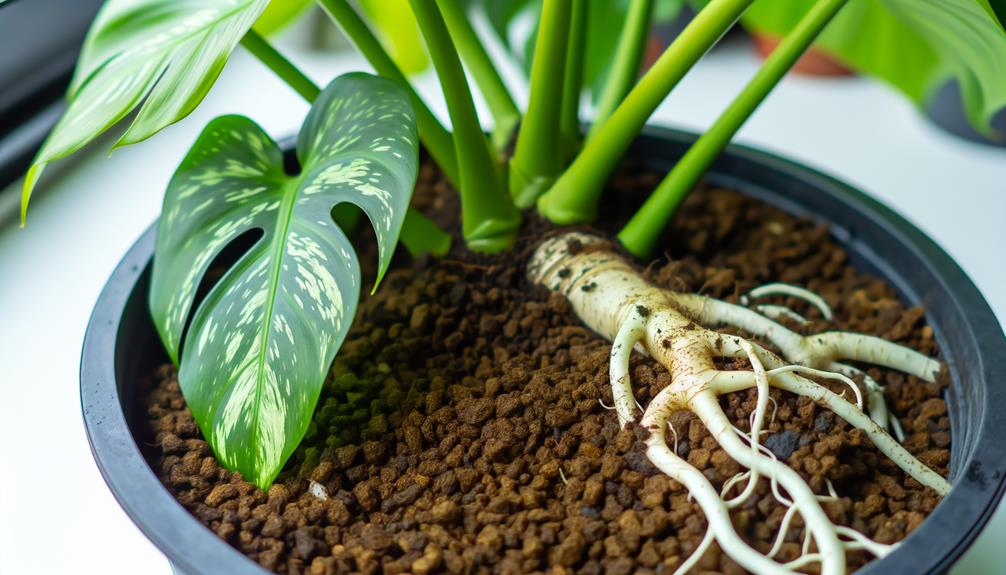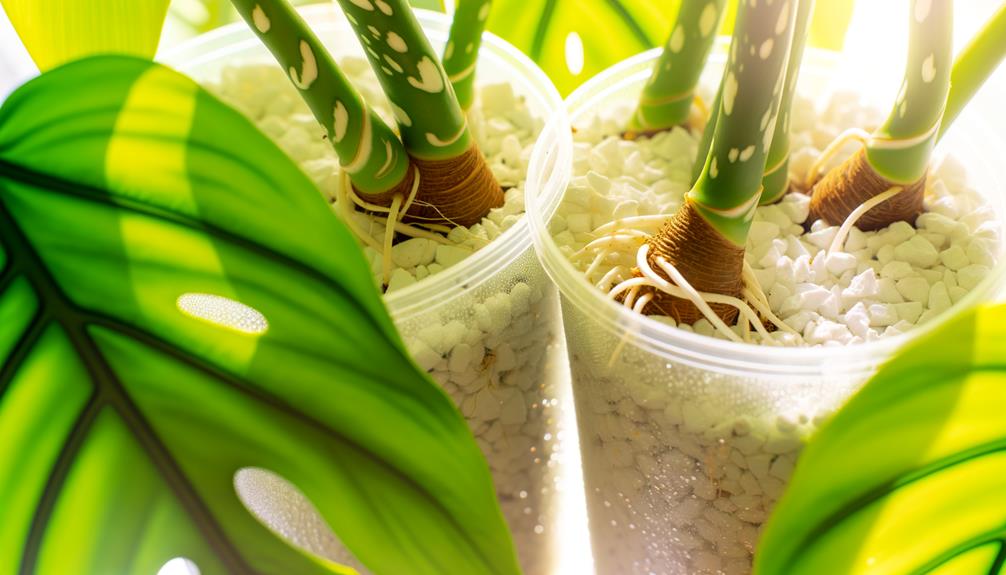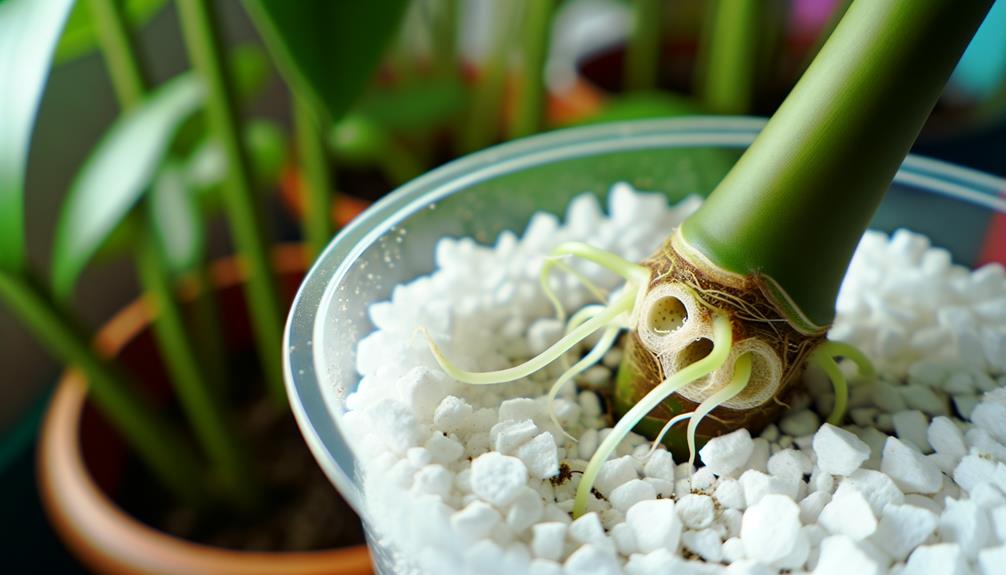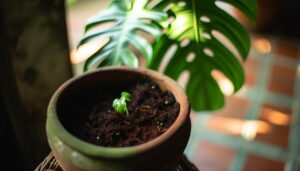Monstera Albo Propagation in Perlite
To propagate Monstera Albo in perlite, start by selecting a healthy cutting with a viable node. Sterilize your pruning shears with isopropyl alcohol and trim any excess leaves.
Rinse the perlite to remove dust and place a base layer of coarse perlite in your clean container. Insert the cutting into moist perlite and spritz it with distilled water.
Maintain high humidity and indirect light. Regularly monitor root development and new leaf growth, and make certain the perlite stays evenly moist.
Watch for root rot or pest issues to intervene promptly. For refined techniques and detailed steps, there's more to discover.

Key Takeaways
- Ensure perlite is thoroughly rinsed to remove dust before use.
- Place Monstera Albo cuttings with at least one healthy node in moist perlite.
- Maintain high humidity and provide indirect light for optimal growth.
- Use sterilized pruning shears and rooting hormone to prepare cuttings.
- Monitor root development through a transparent container to spot firm, white roots.
Why Choose Perlite

Perlite is an excellent medium for propagating Monstera Albo due to its superior aeration and drainage properties.
You'll find that perlite's lightweight, porous structure enhances root oxygenation, essential for root development.
By maintaining a balance between moisture retention and drainage, perlite prevents waterlogging and root rot, common issues in propagation.
Its sterile nature minimizes the risk of pathogens and pests, creating an ideal environment for Monstera Albo cuttings.
When you prepare your perlite mix, make sure it's thoroughly moistened but not saturated.
This medium also facilitates easy monitoring of root growth, allowing you to check progress without disturbing the cuttings.
Necessary Tools
To successfully propagate Monstera Albo in perlite, gather essential tools such as sterilized pruning shears, a clean container, and rooting hormone. Sterilize pruning shears with isopropyl alcohol to prevent microbial contamination.
The container should be transparent to monitor root development and have drainage holes to avoid waterlogging. Opt for a high-quality rooting hormone containing indole-3-butyric acid (IBA) to stimulate root growth.
Additionally, you'll need a spray bottle filled with distilled water to maintain humidity and a hygrometer to monitor ambient moisture levels. Make certain you have perlite, which should be rinsed to remove any residual dust.
Using a small trowel will help you distribute the perlite evenly. These tools guarantee a sterile and optimized environment for Monstera Albo propagation.
Preparing the Cutting

To start preparing your Monstera Albo cutting, choose a portion with at least one healthy node, preferably with aerial roots.
Sterilize your cutting tools using isopropyl alcohol to prevent any potential infections.
Carefully trim the leaves and stem to promote ideal growth in the perlite medium.
Choosing Healthy Nodes
Why is it essential to select healthy nodes for your Monstera Albo cuttings?
Healthy nodes are significant because they contain the meristematic cells responsible for new growth. Look for nodes that are plump, green, and free from disease or damage. You'll find these nodes at the intersection of the stem and petiole, often accompanied by aerial roots.
Avoid nodes that are discolored, shriveled, or have visible signs of rot. Using sterilized pruning shears, make a clean cut just below the node, ensuring that you include at least one leaf and an aerial root if possible. This precision increases the likelihood of successful propagation and robust root development when placed in perlite.
Cutting Sterilization Process
Begin the cutting sterilization process by thoroughly cleaning your pruning shears with isopropyl alcohol to prevent the spread of pathogens. Use a cotton pad soaked in 70% isopropyl alcohol and wipe down the blades meticulously. Ensure you reach all crevices where bacteria or fungi might linger. After wiping, let the shears air-dry completely, making sure no residue remains. This step is essential to maintain the health of your Monstera Albo cuttings.
Next, prepare a clean working surface. Lay down a sterilized cutting board or a sanitized piece of parchment paper. By maintaining a sterile environment, you minimize the risk of introducing contaminants to the cuttings. These precautions are crucial for successful propagation in perlite.
Leaf and Stem Preparation
Carefully select a healthy Monstera Albo cutting with at least one node and a few aerial roots to guarantee successful propagation. Begin by inspecting the cutting for any signs of disease or pest infestation. Using sterilized pruning shears, make a clean cut below a node. This node is vital as it's where new roots will develop.
- Make sure the cutting has at least one node, as it's crucial for root growth.
- Check for vibrant, undamaged leaves, indicating the plant's overall health.
- Look for aerial roots; they speed up the rooting process.
Remove any leaves close to the node to prevent rot. Allow the cutting to air-dry for a few hours, which helps seal the cut end, minimizing the risk of bacterial infection.
Setting Up in Perlite
To set up your Monstera Albo in perlite, start by thoroughly rinsing the perlite to remove any dust particles.
Place the cutting in a container filled with moist perlite, ensuring the node is adequately covered.
Maintain high humidity and indirect light to optimize root development.
Preparing Perlite Medium
For the finest Monstera Albo propagation, begin by thoroughly rinsing the perlite to remove any fine dust particles that could hinder root development. Utilize a fine mesh strainer to prevent losing perlite granules during the washing process.
After rinsing, sterilize the perlite by soaking it in a diluted hydrogen peroxide solution to eliminate any potential pathogens. Drain and allow it to dry partially before setting up your propagation container.
Container:
Select a transparent container with drainage holes to monitor root growth and prevent waterlogging.
Layering:
Establish a base layer of coarse perlite followed by a finer layer to ensure optimal aeration and moisture retention.
Moisture:
Spritz the perlite lightly with distilled water to maintain a humid environment conducive to root initiation.
Execute these steps meticulously for utmost results.
Root Development Tips
Place your Monstera Albo cutting into the prepared perlite, ensuring the node is fully embedded to facilitate root development.
Maintain a moisture level that's damp but not waterlogged; perlite's aeration properties will encourage ideal root oxygenation.
Position your setup in an area with bright, indirect light to promote photosynthesis while avoiding leaf scorch.
Maintain a stable temperature between 65-75°F (18-24°C).
Mist the cutting daily to maintain humidity levels around 60-70%, as dry air can hinder root initiation.
Inspect the cutting weekly for signs of root development, like white root tips emerging from the node.
If you observe any fungal growth or rot, remove affected areas immediately and adjust moisture levels.
Patience is key; roots typically develop within 4-6 weeks.
Monitoring Growth
Regularly examine the root development and leaf formation to secure ideal growth conditions for your Monstera Albo in perlite. Inspect the roots bi-weekly, confirming they're firm and white, indicating healthy growth.
Look for new leaves emerging, which indicates strong plant health. Maintain consistent moisture levels in the perlite to facilitate peak root expansion.
Utilize a transparent container to easily observe root development and adjust care practices as necessary to promote robust Monstera Albo growth.
- Root Evaluation: Search for white, solid roots; avoid brown or mushy ones.
- Leaf Unfolding: Check for new leaves; they should be lively and unfurled.
- Moisture Supervision: Guarantee perlite stays moist but not waterlogged; excessive saturation can impede oxygen flow.
Common Issues
Several common issues can arise when propagating Monstera Albo in perlite, including root rot, nutrient deficiencies, and pest infestations. To mitigate root rot, maintain proper drainage and refrain from waterlogging. Nutrient deficiencies often manifest as yellowing leaves; supplement with a balanced, water-soluble fertilizer. Pest infestations, such as spider mites or aphids, require vigilant monitoring and prompt treatment.
| Issue | Solution |
|---|---|
| Root Rot | Ensure drainage, avoid waterlogging |
| Nutrient Deficiencies | Use balanced, water-soluble fertilizer |
| Pest Infestations | Monitor, treat promptly with insecticidal soap |
| Poor Growth | Adjust light, maintain humidity levels |
Consistently check your cuttings for these issues to maintain healthy propagation. Proper care and immediate action can significantly enhance success rates.
Conclusion
As you monitor your Monstera albo's progress in perlite, you'll begin to notice subtle signs of growth. But don't get too comfortable yet—roots can be temperamental.
Will the new roots thrive, or will they struggle? By maintaining ideal moisture levels and ensuring adequate airflow, you're giving your plant the best chance.
The next few weeks are critical. Stay vigilant, because the reward of a thriving Monstera albo could be just around the corner.






